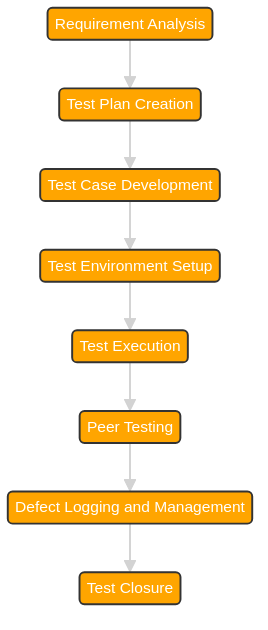In today’s digital landscape, quality software isn’t a luxury; it’s a necessity. While automation is crucial, manual testing remains an indispensable pillar of Quality Assurance (QA). A recent World Quality Report (2023-24) found that 73% of businesses aim for a balanced testing approach, integrating manual and automated methods. The reason? Manual testing’s unique strengths.
Testbytes adopts a unique manual testing methodology that stands out in the industry. Our approach integrates traditional testing techniques with innovative strategies to enhance accuracy and efficiency in identifying bugs and usability concerns.
By prioritizing user-centric scenarios, Testbytes ensures that applications are technically sound, intuitive, and engaging for end-users. This holistic approach underscores the importance of manual testing in delivering high-quality software products in today’s digital landscape.
Testbytes Manual Testing Process
- Requirement Analysis: The process begins with in-depth software requirements analysis. Testers gain an understanding of the functional and non-functional aspects of the application to ensure comprehensive test coverage.
- Test Plan Creation: A test plan is developed based on the requirement analysis. This document outlines the strategy, objectives, schedule, resource allocation, and scope of the testing activities.
- Test Case Development: Testers create detailed test cases that include specific conditions under which tests will be executed and the expected results for each condition. This step is crucial for systematic testing and covers various aspects such as functionality, usability, and performance.
- Test Environment Setup: The necessary testing environment is set up before executing the test cases. This includes configuring hardware and software requirements that mimic the production environment as closely as possible.
- Test Execution: Testers manually execute the test cases and document the outcomes during this phase. They compare the actual and expected results to identify any discrepancies or defects.
- Peer Testing (Added Step):
-
- Integration into Workflow: After individual test case execution, peer testing is introduced as an additional step. This involves having another tester, who did not originally write or execute the test case, review and re-run the tests.
- Benefits: Peer testing brings a fresh perspective to the testing process, often uncovering issues the original tester might have overlooked. It enhances test coverage and accuracy by leveraging the collective expertise of the testing team.
- Execution: Testers can perform peer testing in pairs or small groups, discussing findings and insights collaboratively. This step encourages knowledge sharing and can lead to more innovative testing approaches.
- Defect Logging and Management: Any defects found during test execution and peer testing are logged in a tracking system. This includes detailed information about the defect, reproduction steps, and severity level.
- Test Closure: The testing process concludes with a closure report summarizing the testing activities, coverage, defect findings, and an overall assessment of the application’s quality. This report helps stakeholders make informed decisions about the software release.

Our Creative Approach Towards Manual Testing
Creating Charters and Use Cases from Requirements
We begin by translating the project requirements into detailed charters and use cases. This approach ensures a comprehensive understanding of the application’s expected functionality and user interactions. For each use case, identify the actors involved and outline their impact on the system and the expected outcomes. This methodical preparation lays a solid foundation for effective testing.
Utilizing Exploration Strategies and Guiding Principles
Implement exploration strategies and guiding principles in software testing to direct the execution of test charters.
Similar to simulated user journeys or focused feature investigations, exploration strategies reveal defects that formal testing methods may overlook. Guiding principles, akin to practical wisdom or best practices, assist testers in efficiently traversing the intricate software environments.
Distribute a weekly agenda among the team members, detailing the specific exploration strategies and guiding principles to be applied, promoting a unified approach and cooperative endeavor toward enhancing product quality
Applying IPSOVI in Manual Testing:
The IPSOVI technique offers a structured approach for manual testing, covering every software aspect: Input, Process, Storage, Output, Verification, and Interface.
Testers identify inputs, assess processing logic, examine data storage, validate outputs, check verification mechanisms, and test interfaces for external communication.
This comprehensive method involves creating specific test cases, executing them to observe application behavior, and systematically documenting defects related to IPSOVI components.
Collaboration and review with the development team ensure thorough coverage and improvement.
Applying IPSOVI enhances software evaluation, leading to more reliable, high-quality applications by ensuring all critical areas are rigorously tested and validated.
Enhancing Manual Testing with Visual Validation Tools
Visual Validation Tools revolutionize manual testing by automating the visual comparison of applications across devices and platforms, ensuring UI consistency and enhancing user experience. Here’s how they contribute technically:
- Automated Screenshot Comparisons: Quickly identify visual discrepancies across various environments.
- Cross-Platform Consistency: Guarantee uniform appearance on different devices and browsers.
- Pixel-Perfect Validation: Detect minute visual deviations with precision.
- CI/CD Integration: Incorporate visual checks into automated pipelines for early issue detection.
- Focus on UX: Free manual testers to concentrate on subjective user experience.

Mind Mapping Techniques in Manual Testing
Mind Mapping in manual testing enhances organization and creativity, offering a visual approach to test planning and execution. Here’s how it benefits the testing process:
- Visual Test Planning: Create intuitive diagrams representing test scenarios, requirements, and strategies.
- Enhanced Communication: Facilitate clear, visual communication among team members.
- Efficient Test Case Design: Organize and develop test cases by visually mapping out application features and their interactions.
- Improved Coverage: Identify gaps in testing by visually assessing coverage areas.
- Quick Reference: During testing cycles, use mind maps as a dynamic, easy-to-navigate reference tool.
How Do We Do Manual Testing Ticket Management:
Effective ticket management is crucial in manual testing to streamline issue tracking, resolution, and communication. By leveraging specialized tools and techniques, teams can enhance productivity and ensure software quality. Here’s how to approach ticket management in manual testing:
Centralized Ticketing System
- Tool Integration: Adopt a centralized ticketing system like JIRA, Trello, or Asana to log, track, and manage defects. These platforms provide a unified view of all issues, facilitating better prioritization and assignment.
- Features Utilization: Use tagging, statuses, and filters to categorize tickets by severity, type, and responsibility. This helps in quick navigation and the management of tickets.
Effective Ticket Logging
- Detailed Reports: Ensure each ticket includes comprehensive details like reproduction steps, expected vs. actual results, and environment specifics. Attachments such as screenshots or videos can provide additional context.
- Standardization: Develop a template or guideline for reporting issues to maintain consistency and clarity in ticket descriptions.
Prioritization and Triage
- Severity Levels: Define and use severity levels (Critical, High, Medium, Low) to prioritize issue resolution based on impact and urgency.
- Triage Meetings: Conduct regular triage meetings to review, assign, and re-prioritize tickets, ensuring that critical issues are addressed promptly.
Team Collaboration and Communication
- Cross-functional coordination: Facilitate collaboration between testers, developers, and project managers within the ticketing system through comments, updates, and notifications.
- Feedback Loop: Implement a feedback loop for resolved tickets, where testers verify fixes and provide feedback, ensuring issues are thoroughly addressed before closure.
Continuous Improvement
- Analytics and Reporting: The ticketing system’s tools generate reports on common issues, resolution times, and testing progress. This data can inform process improvements and training needs
Manual Testing Ticket Management: Tools and Techniques
Effective ticket management is crucial in manual testing to streamline issue tracking, resolution, and communication. By leveraging specialized tools and techniques, teams can enhance productivity and ensure software quality. Here’s how to approach ticket management in manual testing:
Centralized Ticketing System
- Tool Integration: Adopt a centralized ticketing system like JIRA, Trello, or Asana to log, track, and manage defects. These platforms provide a unified view of all issues, facilitating better prioritization and assignment.
- Features Utilization: Use tagging, statuses, and filters to categorize tickets by severity, type, and responsibility. This helps in quick navigation and management of tickets.
Effective Ticket Logging
- Detailed Reports: Ensure each ticket includes comprehensive details like reproduction steps, expected vs. actual results, and environment specifics. Attachments such as screenshots or videos can provide additional context.
- Standardization: Develop a template or guideline for reporting issues to maintain consistency and clarity in ticket descriptions.
Prioritization and Triage
- Severity Levels: Define and use severity levels (Critical, High, Medium, Low) to prioritize issue resolution based on impact and urgency.
- Triage Meetings: Conduct regular triage meetings to review, assign, and re-prioritize tickets, ensuring that critical issues are addressed promptly.
Team Collaboration and Communication
- Cross-functional coordination: Facilitate collaboration between testers, developers, and project managers within the ticketing system through comments, updates, and notifications.
- Feedback Loop: Implement a feedback loop for resolved tickets, where testers verify fixes and provide feedback, ensuring issues are thoroughly addressed before closure.
Continuous Improvement
- Analytics and Reporting: The ticketing system’s tools generate reports on common issues, resolution times, and testing progress. This data can inform process improvements and training needs.
Conclusion
Our methodologies are not just procedures; they are the blueprint for success in a digital age defined by user expectations and technological advancements. As we navigate the complexities of software development, our focus remains unwavering: to deliver products that exceed expectations, foster engagement, and drive success.
Don’t let quality be an afterthought in your software development process. Choose Testbytes for manual testing services prioritizing precision, user experience, and efficiency.
Contact us today to learn how our unique approach can elevate your software products, ensuring they are ready to meet the demands of today’s digital landscape. Let’s work together to create exceptional digital experiences that captivate, engage, and endure.
